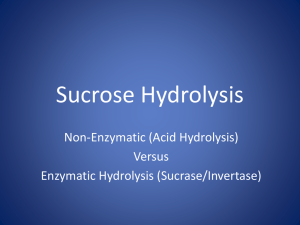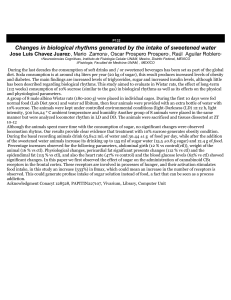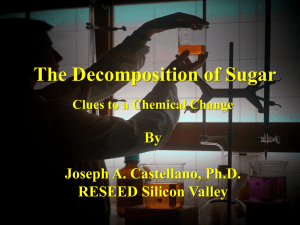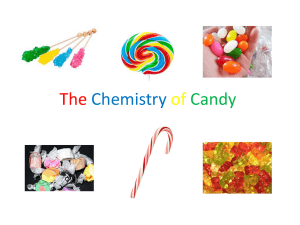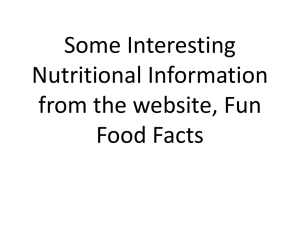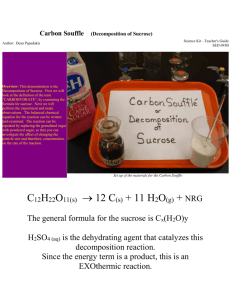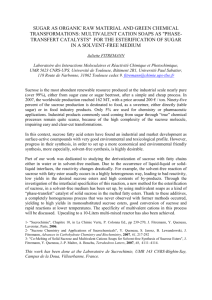PROPERTIES OF SUGAR- PHYSICAL, CHEMICAL AND BIOLOGICAL
advertisement
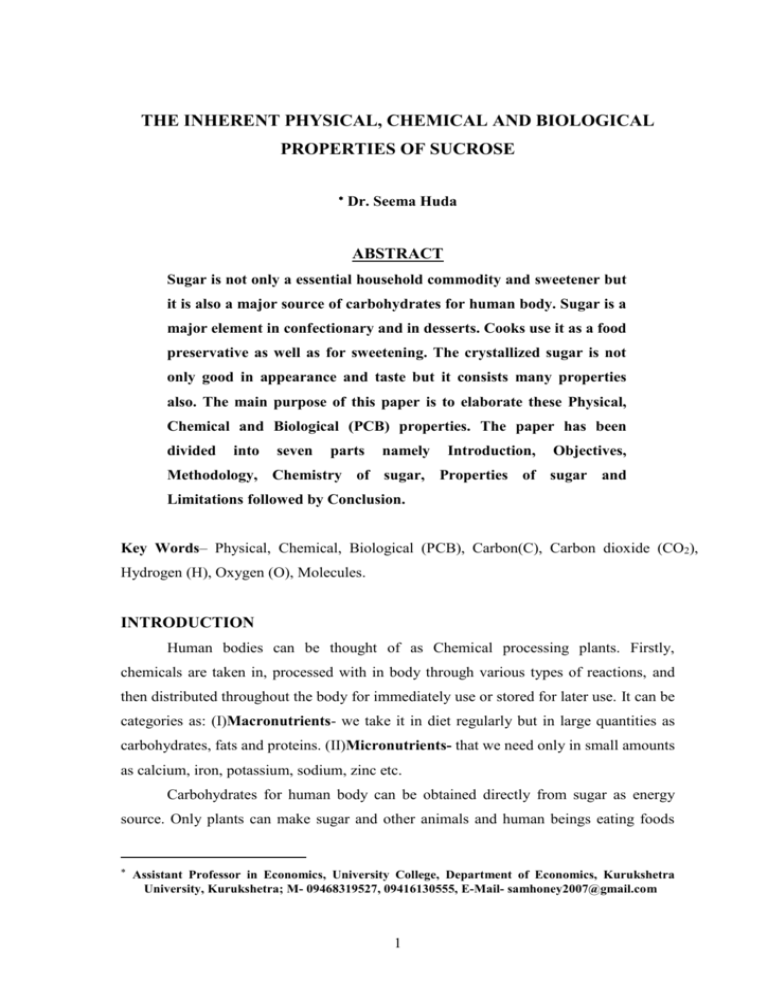
THE INHERENT PHYSICAL, CHEMICAL AND BIOLOGICAL PROPERTIES OF SUCROSE Dr. Seema Huda ABSTRACT Sugar is not only a essential household commodity and sweetener but it is also a major source of carbohydrates for human body. Sugar is a major element in confectionary and in desserts. Cooks use it as a food preservative as well as for sweetening. The crystallized sugar is not only good in appearance and taste but it consists many properties also. The main purpose of this paper is to elaborate these Physical, Chemical and Biological (PCB) properties. The paper has been divided into seven parts namely Introduction, Objectives, Methodology, Chemistry of sugar, Properties of sugar and Limitations followed by Conclusion. Key Words– Physical, Chemical, Biological (PCB), Carbon(C), Carbon dioxide (CO2), Hydrogen (H), Oxygen (O), Molecules. INTRODUCTION Human bodies can be thought of as Chemical processing plants. Firstly, chemicals are taken in, processed with in body through various types of reactions, and then distributed throughout the body for immediately use or stored for later use. It can be categories as: (I)Macronutrients- we take it in diet regularly but in large quantities as carbohydrates, fats and proteins. (II)Micronutrients- that we need only in small amounts as calcium, iron, potassium, sodium, zinc etc. Carbohydrates for human body can be obtained directly from sugar as energy source. Only plants can make sugar and other animals and human beings eating foods Assistant Professor in Economics, University College, Department of Economics, Kurukshetra University, Kurukshetra; M- 09468319527, 09416130555, E-Mail- samhoney2007@gmail.com 1 that contain them such as rice, breads, potatoes etc. It gives them energy. Animals and human break down carbohydrates during the process of metabolism (energy releasing process in the body) and gain energy. The chemical metabolism of the sugar glucose is C6H12O6 + 6O2 6CO2 + 6H2O + energy Human beings eat plants and then they release Carbon dioxide (CO2), Hydrogen (H2O) and energy in metabolic process. OBJECTIVES 1. To elaborate chemistry of sugar in brief. 2. To explain physical, chemical and biological properties of sugar in a simple way with appropriate scientific examples. METHODOLOGY The present study has made use of secondary data to elaborate the inherent properties of sucrose, commonly known as sugar. THE CHEMICAL REACTION BEHIND SUGAR Sugar/Sucrose (scientifically), belongs to one of the families of sugars known as saccharine in the grouping called carbohydrates. Chemically sugar and carbohydrates are synonyms, but sugar refers to sweet, small, soluble carbohydrate and is used as a synonym for saccharose (sucrose). Its scientific name is ‘Saccharum Officinarum’. Scientifically, sugar refers to any monosaccharide or disaccharide. Monosaccharides called ‘simple sugars’ as glucose which stores chemical energy that biological cells convert to other type of energy. Glucose is also found in human blood plasma having the molecular formula C6H12O6. While disaccharide, a crystalline solid, known as ‘table sugar’ or ‘saccharose’. Common sugar (sucrose) is made from sugar beets or sugar cane, edible crystalline substances including sucrose, lactose and fructose. Biochemists regard sugars as relatively simple carbohydrates. Sugars include monosaccharides, disaccharides, trisaccharides and the oligosaccharides– containing 1, 2, 3 and 4 or more monosaccharide units respectively. The saccharine is a large family with general formula CnH2nOn. The simplest of the sugars is glucose C6H12O6, although its physical chemistry is not that simple because 2 it occurs in two distinct forms, the sucrose molecule is compound of twelve atoms of carbon, twenty two atoms of hydrogen, and eleven atoms of oxygen. As C12H22O11 Sucrose (C12H22O11) is a condensation molecule made up of two molecules that are glucose (primary form of sugar stored in human body for energy) and fructose (sugar found in fruits) and both have same chemical formulae C6H12O6. Plants form it only. The process whereby plants make sugar is Photosynthesis. The plant takes in CO2 from the air through pores in its leaves and absorbs water through its roots. These are combined to make sugar. They use energy from the sun and with the help of a substance called Chlorophyll, which is green and allows it to absorb the sun’s energy more readily, and which, gives the plants leaves their green color. The reaction of photosynthesis is 12CO2 + 11H2O C12H22O11 + 12O2 Carbon dioxide + Water Sucrose + Oxygen Hence, oxygen is given off during the process of photosynthesis, and sucrose that is a disaccharide of glucose (left) and fructose (right) that is important molecules in the body are Sucrose (Glucose (12) fructose) Figure 1. Chemical Structure of Sucrose Molecule Since sucrose consists of glucose unit bonded to a fructose unit. When it melted it will decompose into glucose and fructose. AsC12H22O11 + H2O C6H12O6 + C6H12O6 3 Sucrose + Water Glucose + Fructose The chemical metabolism of the sugar glucose is 6CO2 + 6H2O + energy (sunlight) C6H12O6 + 6O2 PROPERTIES OF SUGAR (PCB) 1. Physical Properties of SugarIn appearance sucrose/sugar is solid and colorless, odorless, sweet tasting. It has following physical properties: 1.1 Solubility Sucrose is extremely soluble in water and in alcohol and other polar solvents while insoluble in benzene, ether and other non-polar organic solvents. Generally, at the freezing point of water 180 grams of sucrose are soluble in 100 grams of water and 500 grams at its boiling point. While about 138 grams sugar are soluble in 100 grams of alcohol (ethanol) at room temperature. 1.2 Non-Conductor Sucrose is non-conductor. A pure solution of sucrose will have no conductivity as measured against a water standard and it also reduce the conductivity of salt solutions. 1.3 Sucrose and Water Humidity Sucrose can ‘tie up’ water. It affects the water activity (a w) of the solution in which sucrose is present. As a w = P / Po P= Partial vapor pressure of food moisture Po= Saturation vapor pressure of water Water activity is sometimes referred to Equilibrium Relative Humidity (ERH). Water is a solution of 44o Brix Sucrose (56% moisture) has the same water activity, 0.8, as a mixture of starch and water with a moisture of 20 per cent. Thus, we use sucrose as in the preservation of foods. 1.4 Impact on Vapor Pressure The vapor pressure of water in an aqueous (watery) sucrose solution will decrease with an increase in dissolved sucrose. 1.5 Impact on Surface Tension 4 Adding sucrose in solution increases its surface tension (highly strung state) of the solution. 1.6 Effect on Boiling and Freezing Points Sugar in solution lowering the freezing point and raising the boiling point of that solution in which it added. 1.7 Heat of Solution Decreases When crystalline sucrose is dissolved in water, the temperature of that solution decreases. While for amorphous (shapeless) or milled (moderate) sucrose, the heat of solution is positive. A decrease in temperature is also observed on diluting/adding more water into solution. 1.8 Viscosity Viscosity is the resistance (hindrance) to flow and fluidity is its reciprocal. In sucrose solution, viscosity increases with more solids content but not linearly. While viscosity decreases rapidly with an increase in temperature of that solution. In general term, as sucrose purity decreases its viscosity will increase. 2. Chemical Properties of SugarAll sugars are fairly reactive. Hence, glucose and fructose molecules are bonded together when the sucrose molecule is formed. These two monosaccharides are much more reactive than sucrose. Hence, they act as chemical reducing agents. Chemical properties of sugar are: 2.1 Inversion Reaction In acidic solutions, sucrose will break down into its two components monosaccharides (glucose and fructose). This reaction will accelerate acidity and increase temperature. Most sucrose reaction in solutions, including human metabolism (energy releasing process in body) begin with inversion reaction. 2.2 Thermal Decomposition While crystalline sucrose is dry, it will be stable up to its melting point but when it melted, it will decompose into glucose and fructose. If it is heated to around 200oC, a whole series of decomposition products are formed. Then a non-sweet, dark brown, water-soluble mixture called ‘Caramel’ is produced. Further heating will lead to a Carbon residue (ash) and in the presence of oxygen; this thermal 5 decomposition becomes combustion (burning), forming CO2 and H2O. 2.3 Acidic Degradation In acids, having pH (Hydrogen in concentration) below 3, the resulting monosaccharides from the inversion reaction will form various condensation (release of water) reaction products. This will result into making a series of oligosaccharides, in which many monosaccharides are jointed, as isomaltose, just like disaccharides, and gentiobiosse along with furan-type derivatives. 2.4 Alkaline Degradation The alkaline degradation products of sucrose are more likely to include cleavage (splitting process) products as organic acids. Once the process starts, the primary products released participate in further reactions as formation of cyclic compounds (Ketose and Acids). 2.5 Non-reducing and Stability of Sucrose Sucrose is a non-reducing and stable in heated, up to 1000 C. Its molecule fructose will decompose above 600 C and both glucose and fructose are unstable in alkaline solutions, while sucrose remains most stable. 3. Biological Properties of SugarSugar is an important feed stock for many critical biological reactions. Biological properties are: 3.1 Yeast Fermentation Sucrose/sugar used in yeast fermentation process. Sugar has been used in bread causing to be rise and converting grapes juice into wine. It produces alcohol and CO2 . In baking, sugar added to converted into volatile (flying) compounds that are given off as gas and vapors in the oven. In alcoholic beverage production, in wine making converts the 18 to 24 per cent sucrose content of the pressed grapes juice into 10 to 13 per cent alcohol by volume. Sweet and dessert wines are made by adding additional sugar to the fermenting mixture. 3.2 Biotechnology Lactic acid (found in curd), Citric acid (found in lemon), Butyric acid, Acetic acid, Ketose and many other chemicals are commercially produced by biochemical means with sucrose used as a substrate or starting material. 6 LIMITATIONS 1. Physical, Chemical and Biological properties of sugar are discussed in brief without more scientific complex explanations. 2. Only ring structure of sugar is composed and the linear structure of glucose and fructose remained untouched. 3. Only Disaccharide has been discussed. CONCLUSION After discussing the Physical, Chemical and Biological properties of sugar we conclude that sugar has the properties of solubility, non-conductivity, effecting vapor press and surface tension, affecting boiling and freezing points of water. Along with this sugar has the feature of non-reducement and stability, thermal decomposition and acidic degradation. It helps in yeast fermentation and as a preserver and starting material in biochemical. After decomposing into glucose and fructose it can be again combined into sucrose. Hence, sugar has so many properties and necessary for human body for energy as a carbohydrate that shows the importance of sugar. REFERENCES 1. Article "Sugar", Wikipedia, Encyclopedia (December 2013) www.en.wikipedia.org/wiki/sugar 2. Article by Porto "Ring Structures of Sugars", Portugal (July 1996) www.rpi.edu 3. Article on "Sugar Chemistry", Wageningen University, Nether land www.food_info.net 4. Carpi Anthony (2003), “Carbohydrates”, Visionlearning, Vol. CHE-2(5) www.visionleartrning.com/sugar(2013) 5. Francl Michelle M., Lecture delivered by Professor on “Turning Sugar Inside Out”, at ‘Bryn Mawr College’, December 2013 www.cultureofchemistry.blogspot.com 6. Nelson David L. and Cox Michael M. (2005), “Principles of Biochemistry” Published by W. H. Freeman and Company, New York. 7. Pennington Neil L. and Bake Charles W. (1991), “Sugar- A User’s Guide to Sucrose”, Van Nostrand Reinhold Press, New York 8. Voet Donald, Voet Judith G., Pratt Charlotte W. (1999), "Fundamentals of Biochemistry", Published at John Willey & Sons, Inc., L –14. 7
